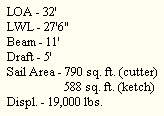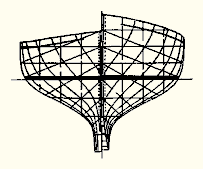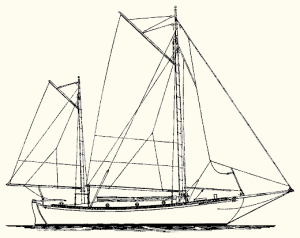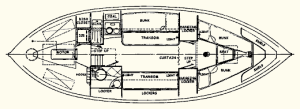

![]()
 WILLIAM ATKIN'S most famous design came out in the
mid-1920's, when small American yachts were beginning a trend toward serious
offshore voyaging which has continued until the present day. MotorBoat editor William Nutting was a major early proponent of this idea, and wanted to
promote the development of suitably seaworthy small yachts. He became interested
in creating a yacht version of the supremely able Norwegian Redningskoites,
Colin Archer designed sailing rescue vessels of about 47', which because of
their beamy proportions lent themselves to miniaturization.
WILLIAM ATKIN'S most famous design came out in the
mid-1920's, when small American yachts were beginning a trend toward serious
offshore voyaging which has continued until the present day. MotorBoat editor William Nutting was a major early proponent of this idea, and wanted to
promote the development of suitably seaworthy small yachts. He became interested
in creating a yacht version of the supremely able Norwegian Redningskoites,
Colin Archer designed sailing rescue vessels of about 47', which because of
their beamy proportions lent themselves to miniaturization.
Nutting, his friend Art Hildebrand, and William Atkin cooperated on concept sketches which appeared under the name Eric, but the design was never finished. After Nutting and Hildebrand were lost at sea, Atkin started over, modifying the hull lines slightly, rearranging the interior, and creating a ketch rig with an alternate cutter version. Three identical ketches were built on speculation by Chute & Bixby, and were launched in 1925 as Eric, Freya, and Valgerda.
 As I was writing this I learned that all three boats survive. It would seem
there is a certain amount of luck associated with the design. Eric's were among the few drawings to survive the 1938 hurricane.
The half model made a short sea voyage and was returned (it had a scratch on it
which the young John Atkin wanted to fix. William wouldn't let him, though, and
the model still hangs on the office wall, scratch and all). Freya is said to have been the only boat not to blow ashore in her nearby anchorage
during the same storm. Eric was blessed to be owned by Herman
Hollerith, who kept her in original condition for 43 years before turning her
over to a succession of owners who appreciated her enough not to change her.
Perhaps the shade of Nutting lends a hand now and then. The boats probably
survive the many years partly because they are almost irresistible in person,
with a sort of tough, competent, and restrained beauty which inspires total
faith and strong affection.
As I was writing this I learned that all three boats survive. It would seem
there is a certain amount of luck associated with the design. Eric's were among the few drawings to survive the 1938 hurricane.
The half model made a short sea voyage and was returned (it had a scratch on it
which the young John Atkin wanted to fix. William wouldn't let him, though, and
the model still hangs on the office wall, scratch and all). Freya is said to have been the only boat not to blow ashore in her nearby anchorage
during the same storm. Eric was blessed to be owned by Herman
Hollerith, who kept her in original condition for 43 years before turning her
over to a succession of owners who appreciated her enough not to change her.
Perhaps the shade of Nutting lends a hand now and then. The boats probably
survive the many years partly because they are almost irresistible in person,
with a sort of tough, competent, and restrained beauty which inspires total
faith and strong affection.
 The design's claim to seaworthiness is based partly on her typical classic
combination of heavy displacement, a long keel, and good diagonals. To this
the Redningskoite form adds great beam and flare above the waterline
providing buoyancy, a large rudder, and motion-damping V-shaped sections
carried right aft to form the Norwegian stern. The latter provides no
flatness in the run, giving a low maximum speed and minimum tendency to surf
on steep waves, while dispersing the energy of waves overtaking the vessel
from aft. The Redningskoite features detract from speed, but are mainly
aimed at survival and utility in violent short seas close to land, where
they had to perform complex maneuvers and even tow fishing vessels off lee
shores under the worst conditions. I have a rare film clip of a
Redningskoite under sail in gale conditions, and the power and agility of
the type in its weather is a revelation. Eric herself has amazed
more than a few people with her good manners and determination when the going
gets tough. Since none of these "inshore" characteristics detracts from the
type's safety in more typical offshore conditions, I think Eric and her kin may well be "the best boat for the worst weather."
The design's claim to seaworthiness is based partly on her typical classic
combination of heavy displacement, a long keel, and good diagonals. To this
the Redningskoite form adds great beam and flare above the waterline
providing buoyancy, a large rudder, and motion-damping V-shaped sections
carried right aft to form the Norwegian stern. The latter provides no
flatness in the run, giving a low maximum speed and minimum tendency to surf
on steep waves, while dispersing the energy of waves overtaking the vessel
from aft. The Redningskoite features detract from speed, but are mainly
aimed at survival and utility in violent short seas close to land, where
they had to perform complex maneuvers and even tow fishing vessels off lee
shores under the worst conditions. I have a rare film clip of a
Redningskoite under sail in gale conditions, and the power and agility of
the type in its weather is a revelation. Eric herself has amazed
more than a few people with her good manners and determination when the going
gets tough. Since none of these "inshore" characteristics detracts from the
type's safety in more typical offshore conditions, I think Eric and her kin may well be "the best boat for the worst weather."
 There are things which could be improved. I would put all the ballast
outside and strengthen the hatches and deck structures, and make the
waterlines in the lower underbody more foil-like, but other than that I
think the design is hard to improve upon without sending her outside her
type.
There are things which could be improved. I would put all the ballast
outside and strengthen the hatches and deck structures, and make the
waterlines in the lower underbody more foil-like, but other than that I
think the design is hard to improve upon without sending her outside her
type.
Of course that is not the same thing as saying everyone needs the best boat for the worst weather, or that she is the best boat all around -- there are many faster boats which have proven their ability to handle the conditions encountered in sensible cruising and offshore voyaging. Perhaps after all the best thing about Eric is the degree to which she is what William Atkin thought a boat should be: a safe and comfortable home, a reliable servant, and a work of art which all who see her seem to love.
![]()
Plans for Eric are $200
BACK TO THE SEA REMAINS THE SAME